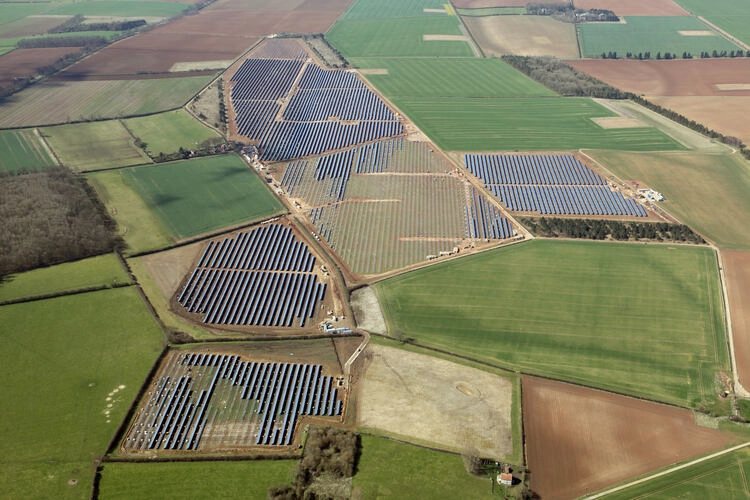
Tom Heap offers a fascinating insight into how we can effectively manage land for both people and the planet in his latest book
By Andrew Brooks
Should we build more wind farms in the UK? How can we raise farm outputs to improve food security? What role can the natural environment provide in carbon capture and storage? These are the types of real-world questions that geographers are called upon to answer, and as geography literally means ‘earth writing’, Land Smart is a book that resonates with the centre of the discipline and advocates for more effective land management as the means to address many pressing environmental challenges.
It’s a call to get our hands back in the soil and our heads around reconciling the competing demands on land, from arable and livestock farming to energy production and carbon storage, to forestry and biodiversity, while valuing nature as a place of beauty and inspiration.
Marshalling land to meet these diverse needs is the most pressing challenge facing the countryside and the topic demands a holistic approach from someone who can move across this varied, topical landscape. Tom Heap will be familiar as a regular presenter on BBC One’s Countryfile, and in Land Smart he takes readers around Britain in an accessible and engaging book that blends entertaining nature writing and insightful analysis of a countryside under pressure. Importantly, it’s a book that tries to provide answers as well as posing questions.
In urban policymaking, the concept of smart cities has recently gained traction. A smart urban area uses science, surveillance and data analysis to improve the lives of citizens, for instance, by constantly changing hundreds of traffic light patterns to manipulate vehicle flows. Land Smart isn’t so in thrall to new technology, although there are many innovations in farming and green energy that can improve the countryside; rather, the solutions proposed are as much about promoting behavioural change as celebrating scientific panaceas.
As observed early on, doing nothing can be the smartest approach, as leaving ‘wild land alone is one of our biggest climate change solutions’. And yet as is urgently demonstrated, doing nothing can’t always be the answer when there’s a need to feed a growing population, cool a warming planet and reverse biodiversity loss.

Solar energy provides a good example of different land-smart approaches. Currently, most of the British land occupied by PV panels is mown grass, enclosed
by fences. Edging the perimeter of a solar park with a food forest can help obscure the visual heft of sharp lines of steel on the landscape and provide a fruit yield and a good, biodiverse habitat on the margins.
The spaces between and underneath panels can be planted with hemp, which improves the soil condition and adds carbon, or clover to fix nitrogen. Going further, sheep could graze between and underneath panels, but this would involve upping the top edge from 1.8 to 2.2 metres, which isn’t usually permitted due to visual intrusion. Allowing a flock of ewes to amble between the metal legs would raise the overall productivity of the land, and the panels can even provide shelter and shade for the sheep, boosting their welfare. These clever solutions require a simple change in attitudes, where multi-use of land is embraced, rather than trying to maximise a single output such as kwh per hectare. So, it’s a smart social change rather than a scientific fix.
A more progressive engineering approach to solar is floating panels on lakes and reservoirs. Installation costs are higher, but productivity may be greater as panel outputs are boosted by the mild cooling effects of water. A moderate level of coverage may even provide habitat variety and anchor points for aquatic plants.

Following his broadcasters’ approach, each section typically begins with a visit to a garden, farm, or forest for a proper in-depth chat with a local expert. Here the language is animated with turns of phrase that put you in the field with them. Early on, he’s pushing through a meadow of wildflowers with an ecologist and ‘a bow wave of butterflies advances in front of us’. On his own allotment, he makes a stinky liquid fertiliser his neighbour refers to as ‘Tom’s evil brew’. Urban spaces awaiting development can be ‘meanwhile gardens’ growing food or flowers to soften the landscape of changing cities.
Land Smart is packed with real-world examples of behavioural changes and scientific innovations that are already delivering meaningful transformation; for example, simple changes to agriculture practices, such as cutting farm traffic on open fields to minimise degrading soil compaction and precision application of nitrogen to reduce costs and damage to water courses.
There are answers out there, but often they’re found on a frustratingly small scale. This, then, is a clarion call for them to be rolled out across the nation. Elsewhere, the carbon credentials of the biofuel sector and the opportunities and constraints of re-wilding the British Isles are robustly debated. The last point is prescient as Heap recognises that many of his UK case studies are nested within environmental issues that are global in scale, and he’s mindful of the ways in which beneficial changes to land use at home can have an oversized environmental footprint elsewhere.




